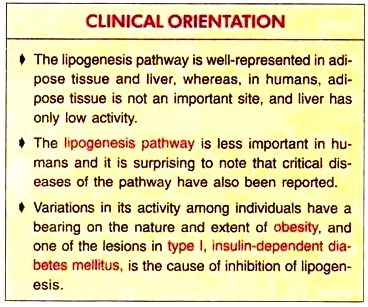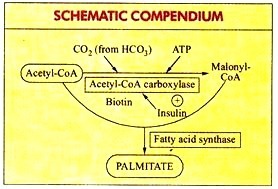The below mentioned article provides a study note on the Fatty Acid Synthesis:- 1. Fatty Acid Synthase 2. Reactions of Fatty Acid Synthesis 3. Sources of Acetyl-CoA 4. Sources of NADPH 5. Citrate and Acyl-CoA Regulate Acetyl-CoA Carboxylase 6. Nutritional State Regulates Lipogenesis 7. Acyl-CoA Regulates Pyruvate Dehydrogenase.
Contents:
- Fatty Acid Synthase
- Reactions of Fatty Acid Synthesis
- Sources of Acetyl-CoA
- Sources of NADPH
- Citrate and Acyl-CoA Regulate Acetyl-CoA Carboxylase
- Nutritional State Regulates Lipogenesis
- Acyl-CoA Regulates Pyruvate Dehydrogenase
1. Fatty Acid Synthase:
It is a multi-enzyme complex. It is an ellipsoid dimer of two identical polypeptide monomers. It is made up of 6 enzymes and 1 acyl carrier protein (ACP).
Each subunit consists of:
a. Ketoacyl synthase.
b. Acetyl transacylase.
c. Enoyl reductase.
d. Hydratase.
e. Ketoacyl reductase.
f. ACP.
g. Thioesterase.
The acyl carrier protein contains 4′- phosphopantetheine as its prosthetic group which was an -SH group.
The cystine -SH of one monomer lies close to the phosphopantetheine SH (Pan -SH) and vice versa.
2. Reactions of Fatty Acid Synthesis:
a. Acetyl-CoA is first carboxylated to malonyl-CoA by acetyl-CoA carboxylase with the help of ATP. Acetyl-CoA carboxylase has a requirement for biotin and it is a multi-enzyme protein.
This reaction takes place in two steps:
(i) Carboxylation of biotin.
(ii) Transfer of the carboxyl to acetyl-CoA to form malonyl CoA.
Acetyl-CoA carboxylase is a rate limiting enzyme, it is an allosteric enzyme with citrate as its activator and palmityl-CoA as its inhibitor.
Once malonyl CoA is synthesized, rest of fatty acid synthesis reactions take place on fatty acid synthetase.
b. Acetyl-CoA combines with Cysteine-SH group catalyzed by acetyl transacylase:
c. Malonyl-CoA combines with adjacent – SH on the 4′-phosphopantetheine of ACP of the other monomer catalyzed by malonyl transacylase.
There is a formation of acyl (acetyl) malonyl enzyme.
d. The acetyl group attacks the methylene group of malonyl residue, catalysed by 3- ketoacyl synthase to form 3-ketoacyl enzyme.
e. 3-ketoacyl enzyme is reduced by 3- ketoacyl reductase to form 3-hydroxyacyl enzyme by the help of reduced NADP.
f. 3-hydroxyacyl enzyme is dehydrated by hydratase enzyme to form 2, 3-unsaturated acyl enzyme.
g. This is again reacted by enoyl reductase to form acyl enzyme by the help of reduced NADP.
h. This acyl enzyme is acted upon by thioesterase with the addition of water to form palmitate after recycling through steps (1) to (4) seven times.
Acetyl-CoA + 7 malonyl-CoA + 14 NADPH + 14H+ Palmitate + 7CO2 + 6H2G + 8CoA.SH + 14NADP+.
Recently it is suggested that butyryl-CoA is the primer molecule in mammary gland.
3. Sources of Acetyl-CoA:
a. Acetyl-CoA is mainly found in mitochondria which cannot pass out. It forms citrate by reacting with oxaloacetate. Citrate is transported out by a transporter protein in exchange of malate. By the presence of enzyme citrate lyase in cytosol, citrate is catalysed to form Acetyl-CoA and oxaloacetate.
b. Carnitine palmitoyl transferase-1 combines acetyl-CoA with carnitine to form acyl carnitine which enters into matrix and is cleaved by carnitine palmitoyl transferase 11 to form acetyl-CoA.
4. Sources of NADPH:
a. Hexose monophosphate pathway is the main source of NADPH.
b. By the presence of malic enzyme malate is oxidatively decarboxylated to pyruvate and NADPH is produced.
c. The extra mitochondrial isocitrate dehydrogenase (probably not a substantial source).
5. Citrate and Acyl-CoA Regulate Acetyl-CoA Carboxylase:
a. The rate limiting is at the acetyl-CoA carboxylase step.
b. Acetyl-CoA carboxylase is activated by citrate, which increases in concentration in the well-fed state but it is inhibited by long-chain acyl-CoA molecules. Therefore, if acyl-CoA is accumulated, the synthesis of new fatty acid is reduced.
c. Acyl-CoA also inhibits the mitochondrial tricarboxylate transporter preventing activation of the enzyme by citrate.
6. Nutritional State Regulates Lipogenesis:
a. The rate of lipogenesis is higher in well- fed animal whose diet contains a high proportion of carbohydrate. It is depressed on a high fat diet or where there is a deficiency of insulin as in diabetes mellitus.
b. The greatest inhibition of lipogenesis is the fat in the diet.
c. Lipogenesis is higher where sucrose is fed instead of glucose. Because, fructose bypasses the phosphofructokinase control point in glycolysis and is flushed by lipogenic pathway.
Hamones regulate lipogenesis:
a. Insulin stimulates lipogenesis by increasing the transport of glucose into the cell and thereby increases the availability of pyruvate for fatty acid synthesis.
b. Insulin converts the inactive form of pyruvate dehydrogenase into active form in adipose tissue.
c. Insulin activates acetyl-CoA carboxylase. It also depresses cAMP and inhibits lipolysis. It also antagonizes the action of glucagon and epinephrine.
7. Acyl-CoA Regulates Pyruvate Dehydrogenase:
Acyl-CoA inhibits pyruvate dehydrogenase by inhibiting the ATP-ADP exchange transporter of the inner mitochondrial membrane which leads to an increased intra-mitochondrial [ATP]/[ADP].




